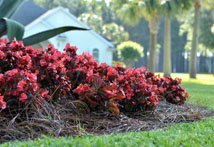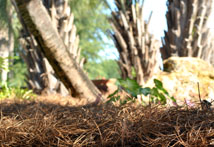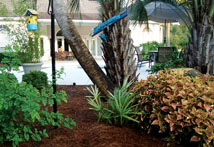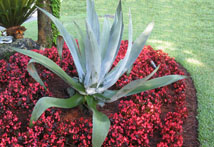Pine Straw Tips & Uses Organic Landscaping Mulch
Pine straw is a natural landscaping mulch (garden mulch) that is attractive, decomposes slowly, resists compaction, and is easy to work with. Pine Straw is often available commercially or is free if you have pine trees on your property. Below are common questions and answers about using our pine straw as a natural, organic landscaping mulch.

Q: Why use pine straw as a natural landscaping mulch?
A: Pine straw's auburn-like color gives a beautiful, clean, decorative covering for landscape and gardens and acts as a weed retardant as well. Pine straw is an organic landscaping mulch (garden mulch) that retains moisture, decomposes and is high in nitrogen. As pine needles break down they acidify the soil, making an excellent landscaping mulch for acid-loving plants, trees and shrubs (such as camellias, azaleas, hydrangeas, fuchsias, gardenias, ferns, dogwoods, magnolias, holly and all evergreens). Pine straw adheres well to slopes and will help your garden or landscape resist erosion by acting as a blanket, shielding feeder roots of plants from harsh weather. Pine straw helps to keep your garden insect- and rodent-free.

Q: How do I apply pine straw as my organic landscaping mulch?
A: Pine straw application is best done by hand, 2 to 3 inches deep. Because pine straw helps retain soil moisture, do not cover the base of the plant. Extend the pine straw to the drip line of the plant, keeping it 2 to 3 inches away from plant base and the trunks of trees and shrubs. This will also discourage rodents from feasting on the bark.
Pine straw is perfect to use in areas such as: home and commercial landscapes, foundation planting, flower beds, natural areas, pathways and steep banks.

Q: How much pine straw do I use?
A: Pine needles are sold in bales like straw, each bale weighs approximately 25 pounds. Custom Pine Straw has highly compressed bales that are 13x14x28 inches and contain 3 cubic feet of pine straw. Each bale will cover 35-40 square feet when applying the recommended 2 to 3 inches deep.
Also see our Pine Straw Coverage Calculator to see how many bales of pine straw you need.

Q: Why are pine needles a hot new commodity?
A: "Landscapers prefer pine straw mulch to bark nuggets or wood chips, because pine straw doesn't wash away as easily. It's a nice color, and it will eventually break down, providing extra organic matter for the soil. Builders like to spread pine straw at building sites to prevent the soil from being disturbed too much by their heavy equipment." (This answer courtesy of: USDA.gov.)

Q: What other information can you tell me about using pine straw?
- Pine straw acts as natural blanket. In the summer it keeps plants cooler and in the winter it keeps plants warmer.
- Your pine straw should be replaced once a year if you are using it to protect plants and add nutrients back into the soil. If you are using it for looks replace the straw twice a year; in the spring and before winter.
- Myth: Pine straw is very acidic and will hurt plants. Pine straw mulch is a 6.0 - 6.5 on the pH scale which can equivalent to drinking water.
- Termites do not like pine straw mulch and will not go near it.
- Use pine straw mulch to protect against erosion and weeds. It also keeps the soil moist for healthy plant growth.

Q: Who uses pine straw mulch?
A: Pine straw is used by a lot of people and companies in the US for a wide variety of reasons. Below is a list of some people who use pine straw mulch but not limited to:
- Contractors
- Master Gardeners
- Landscapers
- Golf Course Management
- Home Improvement Stores
- Highway Developers
- Zookeepers
- Housing Developments
- Retailers
- Garden Centers
- Environmentalists
- Homeowners
Buy Wholesale Pine Straw by the Truckload
Our pine straw bales are sold wholesale at wholesale pricing. Each pine straw bale contains over 3 cubic feet of highly compressed pine needles.
Using pine straw as a natural garden mulch keeps down weeds, traps moisture, prevents topsoil erosion, and even keeps the soil around the plants at a stable temperature. This is incredibly important with newer plants or those with shallower root systems.
Read More
Our pine straw
Our pine straw
Our pine straw
Get a wholesale pine straw quote now
Connect With Us:
You Might Be Interested In:

Many Uses for Pine Straw
All over the world different species of pine needles are used for art, healing, cleaning and more ...
Wholesale Pinestraw Tips
Pine straw is economical mulch for garden beds or landscapes of all types ...